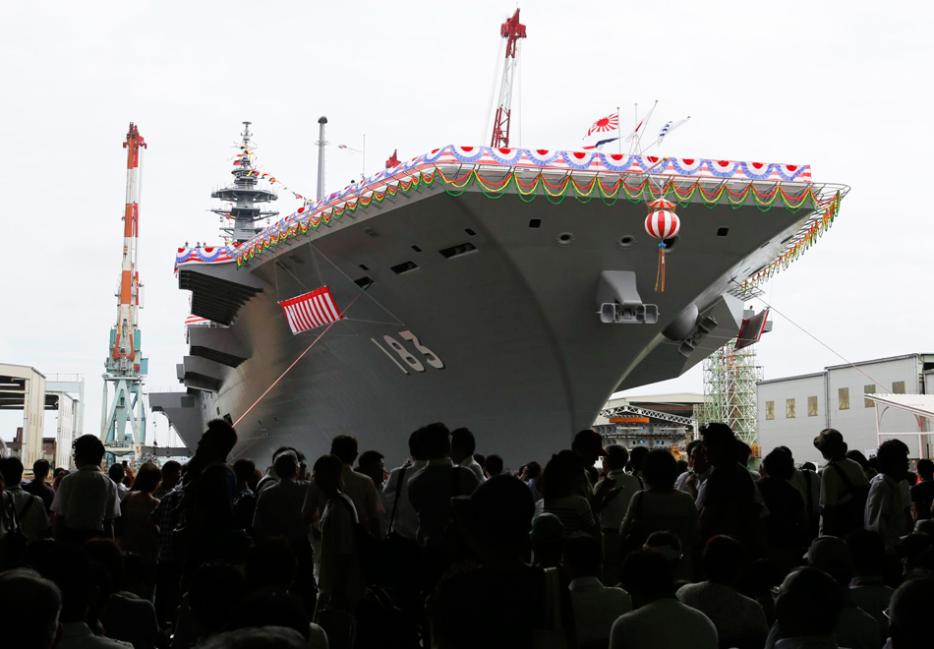Sentences are like machines, in that some parts do more work than others. So when someone writes “Japan launched its largest warship since the end of World War II,” the part that comes after “the end of” is really putting the rest of it on its back. This Izumo is a 19,500-ton helicopter carrier and is, indeed, the largest ship the Japanese have put in the water since the end of World War II. This, however, says much more about Japan’s long military naptime than it does about the Izumo, which would have been middling even on the scale of WWII-era warships, much less the 100,000-ton Nimitz-class carriers of the US Navy.
However we rank its size, the Izumo has restarted the conversation over a subject that has only been punctuated with breaks since the end of the Cold War: Japan’s role in maintaining peace and order in the North Pacific. It is, understandably, a touchy topic, with countries such as South Korea and China doing little to hide their anxiety every time Japan buys a new piece of hardware. The fact that the Izumo could, hypothetically, also support vertical-takeoff planes like the F-35B isn’t helping anyone’s nerves.
Which is silly, really, because however obnoxious and offensive the government of Shinzo Abe is when it comes to the memories of Japan’s imperial victims, the situation in Asia is wildly different in 2013 than it was in 1945. Even if Japan is nurturing irredentist dreams, it has no capacity to ever implement them. The rise of China and South Korea from colonial disarray to major industrial powers has permanently put a cork in that bottle.
That’s not the real danger the Izumo represents, though. The Izumo is just one of several major warships being put to sea in the Pacific. The US Navy is building three Zumwalt-class destroyers, each of which will be 15,000 tons and are more or less explicitly aimed at Chinese sea power. The Chinese, for their part, are building warships with gusto and are taking the first steps towards developing seaborne air power with a converted Russian aircraft carrier they’ve renamed the Liaoning. Not to be outdone, India is building two carriers to join its own Russian refurb. Smaller powers such as South Korea, and Vietnam are also spending heavily on their militaries.
One of the more interesting points of continuity between the Bush and Obama administrations has been the intense focus on building relations with powers in Asia who are worried about China’s increasing military power. Everything from the US nuclear deal with India negotiated under Bush to the opening of relations with Myanmar under Obama can be understood as an effort to surround China with countries that see their interests coinciding with Washington’s. The risk, of course, is that China could lash out in a sense of isolation.
In Confront and Conceal, David Sanger quotes a highly placed Obama aide as saying, “If we get China wrong, in thirty years that’s the only thing anyone will remember.” It is a delicate balancing act, not least because, unlike the small-fry wars in Iraq and Afghanistan, there’s the risk of real, major-power conflict for the first time since the fall of the Berlin wall.
Even more sobering is that we really have no idea what modern war between two major, modern powers would look like. We are as far from the last plausible example—the 1973 Yom Kippur War—as Hiroshima was from the Russo-Japanese War. Those Zumwalt destroyers are designed to carry laser weapons to shoot down incoming ballistic anti-ship missiles. The US has figured out how to land drones on an aircraft carrier. If we’re so profoundly unfortunate as to exchange fire in the Pacific again, it’s going to be done with weapons we’ve never seen in action before.
This is, of course, all a long way off, and if we’re smart and really lucky we may manage to smooth things out. But the future has a way of sneaking up on us when we’re not careful.






